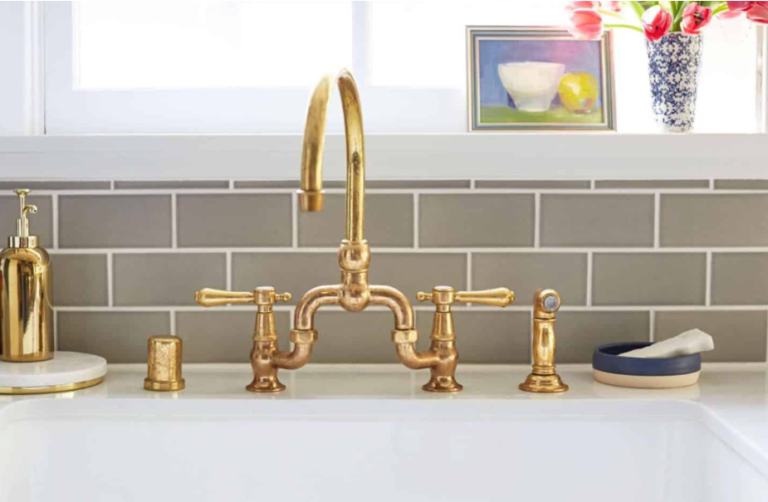Installing the best brass kitchen faucet can be a great way to upgrade your kitchen and add a touch of luxury to your cooking space. But before you leap, there are a few things you should know. From choosing the right style to understanding the basic installation process, you have to know about it. With the right preparation and knowledge, you can install a brass kitchen faucet with ease and confidence.
Benefits of installing a brass kitchen faucet
Brass kitchen faucets are a great option for homeowners looking to add a touch of luxury to their kitchens. There are a few benefits to installing a brass kitchen faucet, including:
– Increased longevity – Brass kitchen faucets are built to last and can last for decades with proper cleaning and maintenance.
– Variety of styles – Brass kitchen faucets come in a variety of styles, so you can choose the perfect one to fit your kitchen and decor.
– Eco-friendly – Brass faucets are made from recycled materials and are completely free of any harmful chemicals so you can rest easy knowing you’re making a sustainable and eco-friendly choice for your home.
Types of brass kitchen faucets
One of the first things you’ll need to decide when installing a brass kitchen faucet is what type of faucet is right for your space. There are a few different types of brass kitchen faucets, including:
– Deck-mounted – If you have an older kitchen or want to install your faucet in a more modern or minimalist space, a deck-mounted faucet may be the way to go. Deck-mounted faucets are installed directly under the sink and offer a sleek, modern look.
– Wall-mounted – Wall-mounted faucets are perfect for larger kitchens or those with a more traditional design. Wall-mounted faucets are installed on the wall above the sink, so they have a larger footprint and can be used with a variety of sink types.
– Pull-out – A pull-out faucet is designed to sit on the countertop next to your sink and offer easy access to filling pots and bowls.
Measurements for brass kitchen faucets
There are a few measurements you should take before you begin installing your brass kitchen faucet to ensure it will fit your sink and space correctly. First, measure the distance from the wall to the underside of your sink. This will tell you how far out your new faucet will sit from the wall and how much workspace you’ll have underneath it.
You’ll also want to measure the distance from the back of your sink to the front of the faucet you’re considering. As a general rule, faucets should extend between one and two inches beyond the front of your sink. You’ll also want to be sure your new faucet will work with your sink type and have the right connections for your water source and hose length.
What tools are needed for installation
When installing a brass kitchen faucet, you’ll need a few basic tools to get the job done. You’ll want to make sure you have a set of pliers, a screwdriver, and/or a wrench before beginning the installation process. Depending on the type of faucet you’re installing, you may also need a wrench or screwdriver with a hexagonal bit to tighten the connection between your water lines and the faucet.
Tips for installing a brass kitchen faucet
– Read the installation instructions – It may seem like a no-brainer, but don’t skip the installation instructions that come with your faucet. These will provide helpful tips and advice for installing a brass kitchen faucet correctly and safely.
– Disconnect your water lines – Before you begin installing a brass kitchen faucet, make sure to disconnect your water lines so you don’t accidentally cause any damage or leak where you don’t want it.
– Clean your sink and surrounding area – Before you begin any installation work, make sure to clean your sink and surrounding area thoroughly. You don’t want any debris or grime to get in the way while you’re working.
– Plan your installation – Think about your plumbing layout before you install your new faucet so you can plan for any potential issues.
Cleaning and maintaining a brass kitchen faucet
Once you’ve installed your new brass kitchen faucet, you’ll want to make sure you’re cleaning it correctly and maintaining it properly so it lasts for years to come. Here are a few tips for taking care of your new faucet:
– Use a brass cleaner – It’s best to use a brass cleaner rather than a standard cleaning solution to clean your new faucet. This will protect the finish and keep your faucet looking its best.
– Avoid abrasive cleaners – While a brass cleaning solution will keep your faucet looking clean and shiny, avoid using abrasive cleaners on your new faucet. This will help protect the finish and keep it looking beautiful for years to come.
– Clean the hose and spout regularly – Another thing you’ll want to do regularly is clean the hose and spout on your faucet. These areas can get dirty quickly, so be sure to clean them out at least once a week to keep your faucet running smoothly.
– Clean the faucet regularly – You should clean your faucet regularly to keep it looking new and keep it running smoothly. Most faucets will come with cleaning instructions from the manufacturer, so be sure to follow these closely.

